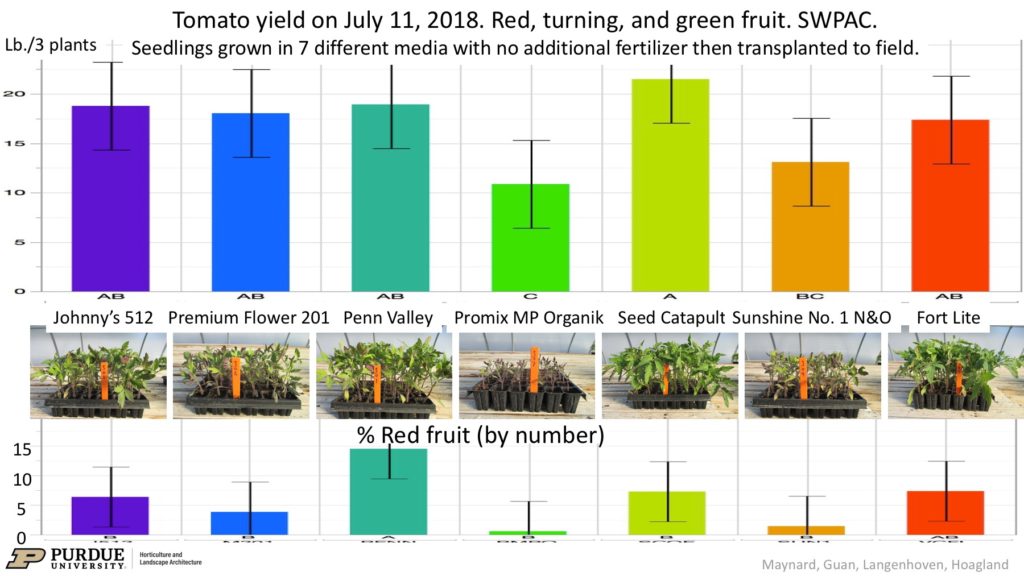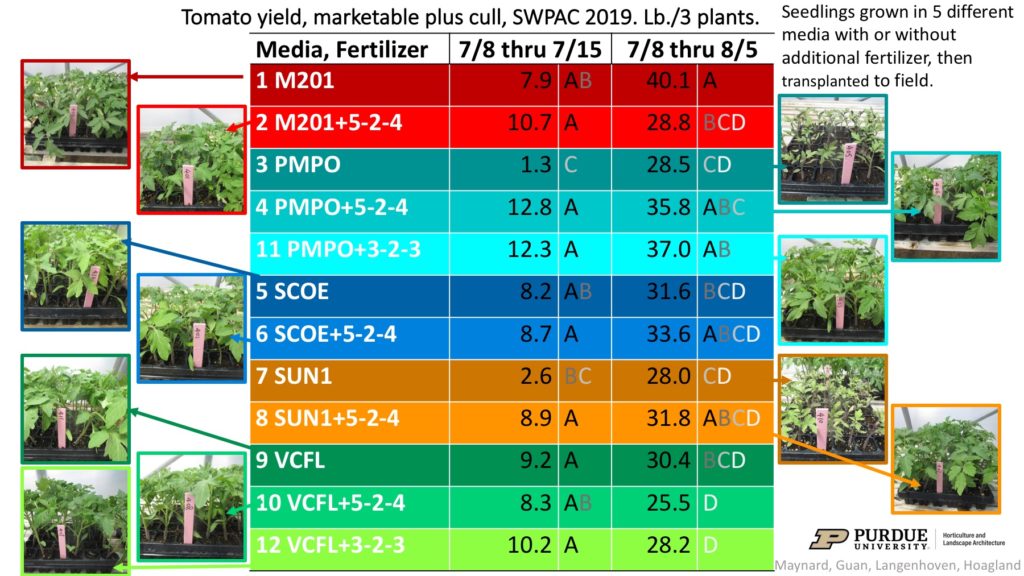We know from published research that the health and quality of a vegetable transplant affects how it will establish, grow, and yield in the field. Our recent work comparing tomato and cucurbit seedling growth in different organic growing media and with and without added fertilizer has provided some good examples of this. See Vegetable Crop Hotline issues 653 and 668 for descriptions of media. Tomatoes flowered and set fruit earlier, and had greater early yield when the seedlings were grown in a media that sustained good growth (Figure 1), or if in a media with low fertility but were provided additional nutrients from solid or liquid fertilizer (Figure 2).
What does this mean for transplant producers? Plan to provide nutrients the seedlings need, either pre-mixed in the growing media or by adding fertilizer. Among the media for organic production that we tested, additional fertilizer was most beneficial to those media that did not contain compost. If the seedlings run out of nutrients during production, provide more –but take time to verify that lack of nutrients is the problem, and not an issue with media pH, root disease, or other problems. A variety of nutrient sources are suitable for transplants. Choose one that works with the production system, water, and growing media in your operation. Below are details about what we used in the trials, but that information is not meant to be a recommendation.
The fertilizers used in these trials were either mixed into the growing media before seeding, spread as a top-dressing as seedlings emerged and after a few weeks of growth, or applied periodically with irrigation. We used just one rate for each fertilizer and so can’t say for sure what the optimum rate would be for each growing medium. We did see increases in media salinity with fertilizer, and that was associated with delayed germination in some media, suggesting that the rates we used were too high. The dry fertilizer was Sustane 5-2-4, used at a rate of 25 lb./cu.yd. I would not recommend incorporating this much prior to seeding for transplant production. Top-dressing half that rate after emergence seemed to be ok if evenly spread across the flats, but I am not ready to recommend that. The liquid was Envirokure 3-2-3, mixed to a concentration of 500 ppm nitrogen (N) (2.25. fl. oz. per gallon of water), and applied several times during production. We did observe some leaf burn if solution was not rinsed off leaves, and this product increased media pH. Typically fertilizer solutions for transplants contain 75 to 200 ppm N, so I expect a lower rate could be used with success.
These results are a reminder that paying attention to transplants can pay off later in the season, especially when early yield is important. Managing transplant growth is a balancing act to achieve a plant that is growing well with a well-developed root system: not so large or flimsy that it will get damaged in the transplanting process, and not so small, restricted in growth, or hardened off that its development in the field delays yield. High nitrogen fertilization and increasing moisture amounts promote top growth over root growth. The ideal transplant can look different in terms of size, developmental stage, and degree of hardening, depending on the production system. In any situation providing seedlings with adequate nutrients is important for a productive transplant.
Please let us know if you find this article helpful! Respond to a quick survey at https://purdue.ca1.qualtrics.com/jfe/form/SV_54rCQ6xW3w7ZcXz

Figure 1. Early tomato fruit harvest and percent of fruit that are red from plants grown in seven different growing media and then transplanted to the field with no additional fertilizer. Yield in lb./3 plants includes all red, green, and turning fruit on plants. Bars with labeled with the same letter do not differ significantly based on Fisher’s protected LSD. Error bars represent ± 95% confidence interval. Photos by W. Guan.

Figure 2. Tomato yield (marketable plus cull fruit) for plants grown in five different growing media with or without additional fertilizer, and then transplanted to the field. Growing Media: M201=Premium Flower 201. PMPO=Promix MP Organik. SCOE=Seed Catalpult. SUN1=Sunshine No. 1 N&O. VCFL=Fort Lite. Fertilizer: 5-2-4=Sustane 5-2-4. 3-2-3=Envirokure 3-2-3. Means within a column followed by the same letter do not differ significantly based on Fisher’s protected LSD. Photos by W. Guan.